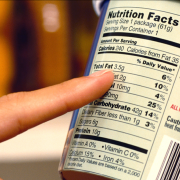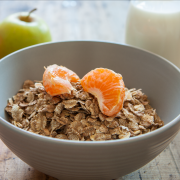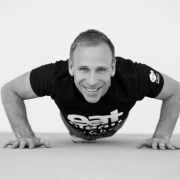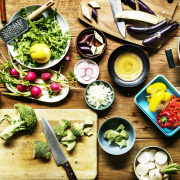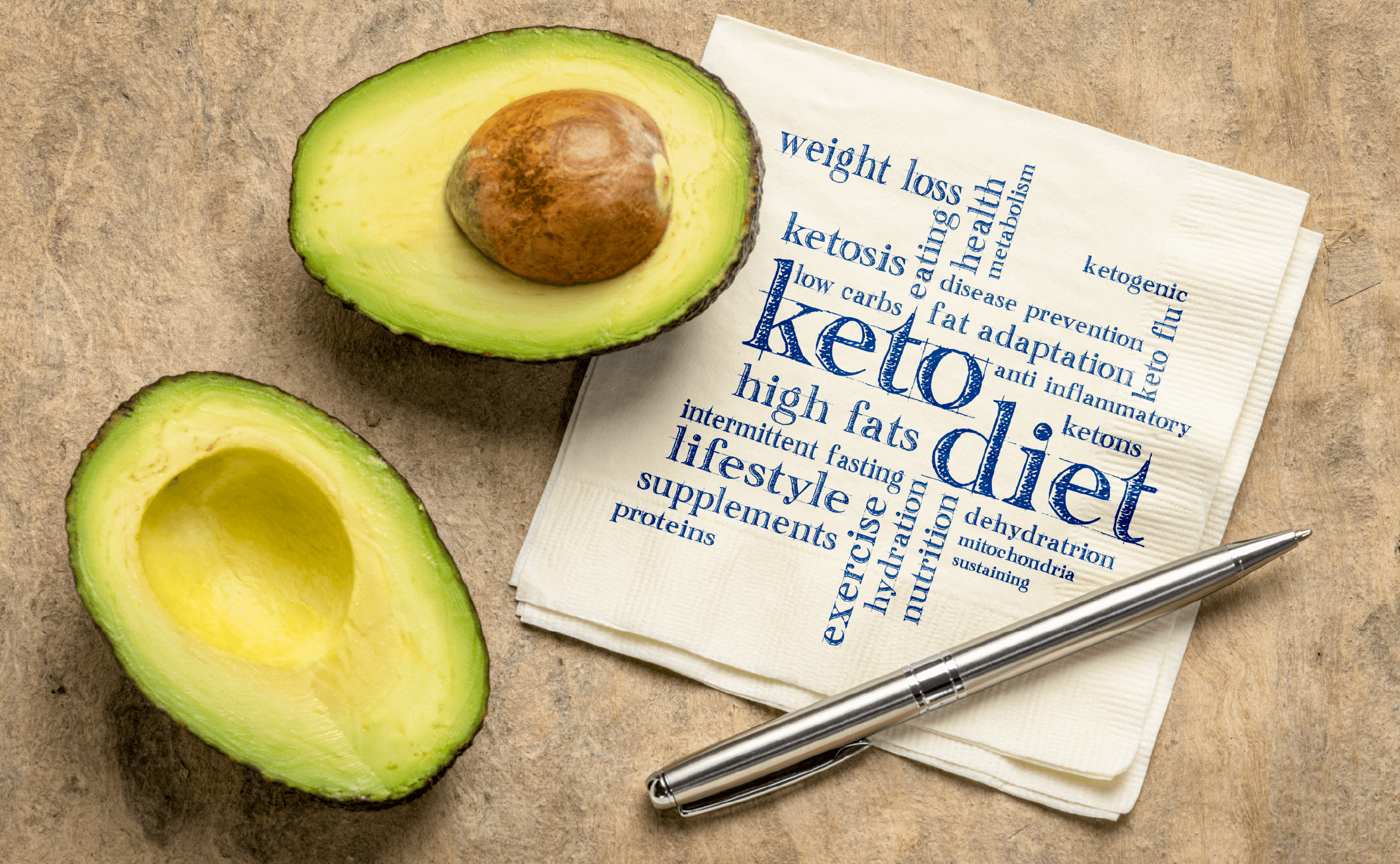
How does it work?
When you drastically cut carbs from the diet, the body makes ketones. Ketones are molecules that are normally made by the liver and used by the body as an energy source instead of using carbs when carb intake is low. The end-goal of a
ketogenic diet is to induce ketosis: a metabolic state where your body switches from using glucose (sugar) as energy to using ketones. Studies have shown that the brain (which normally uses glucose for energy) can use ketone bodies as an alternative fuel. Ketones also have an appetite-suppressing effect, thus helping with weight loss.
What do you eat on a ketogenic diet?
A ketogenic diet is super high in fat (about 80% of total calories/energy), very low in carbohydrates (5% of total calories/energy or 20g of carbs per day) and low in protein (about 15% of total calories/energy). Keto diet staples include mostly high fat, low carb foods and low to moderate amounts of protein. You’ll be eating more meat, chicken, fish, eggs, fats, and low carb veg, and avoiding sugar- and sugar-containing foods and drinks, alcohol, starches, grains and most fruit. It is estimated that we need about 5 days of eating this way to induce ketosis. However, if not done properly, there is a risk of never entering ketosis.
It is important to note that a Keto diet is not supposed to be a Carnivore diet. You are only eating 15% protein which is the same as 225g of
extra lean meat per day (based on a 1800kcal diet). To achieve 80% fat, 15% protein and 5% carbs on a 1800kcal meal plan you would need to eat about 180g Oil (13 < tablespoons < of olive oil), 225g extra lean meat, and 560g green and coloured veg.
|
Do’s |
Don’ts |
|
> Poultry e.g. chicken, turkey, ostrich > Fish: white fish e.g. hake, tuna; fatty fish e.g. salmon > Eggs (whole) > Full cream dairy e.g. milk, yoghurt, cheese > Cream > Avocados > Olives and olive oil > Coconut oil > Nuts e.g. almonds, cashews, macadamias, Brazil nuts, pecan nuts > Nut butter e.g. almond butter, macadamia nut butter > Butter > Seeds e.g. pumpkin, linseeds, flaxseeds > Low carb veg e.g. leafy greens (kale, spinach, cabbage), broccoli, cauliflower, mushrooms, tomatoes, onions, peppers > Berries in small portions e.g. blueberries, blackberries, strawberries) |
> Sugary treats e.g. sweets, chocolates, pastries > Sugary drinks > Sweetened dairy e.g. sweetened yoghurt > Cereals > Grains e.g. rice, corn, quinoa, barley > Bread > Pasta > Legumes e.g. beans, chickpeas, lentils > Starchy veg e.g., potato, sweet potato, baby potatoes > Fruit e.g. oranges, grapes, mangos, apples, papaya, pineapple, bananas, dried fruit > Alcohol |
What are the benefits of a ketogenic diet?
Despite the recent hype, the ketogenic diet is not new to the nutrition world and was
originally used in the 1920s to help with seizures in children with epilepsy.
Because of these neuroprotective
effects, there may also be benefits for brain disorders like Parkinson’s,
Alzheimer’s, multiple sclerosis, sleep disorders, autism, and brain cancer, but
more human studies are still needed. A ketogenic diet has also been shown to improve blood sugar control in type 2
diabetics, at least in the short term. Though cholesterol rises at first due to the breakdown of plaque buildup in the blood vessels, there are cholesterol-lowering benefits seen on this diet, but scientists think this is from the weight loss experienced and not the fact that you on this diet.
But without a doubt most people go keto for weight loss and there is
some evidence of quicker weight loss when on this diet (compared to a
traditional low-fat diet or a Mediterranean diet). Ketogenic diets
may accelerate the start of weight loss. Weight loss comes from a decrease in
the amount of energy eaten each day (like all types of energy-controlled
diets). This is because of feeling fuller from eating large amounts of fat and
protein.
Are there side effects of a ketogenic diet?
Once
the levels of ketones in the blood rise and you enter ketosis, this is
accompanied by the so-called ‘Keto Flu’: dry mouth, increased urination, and
bad breath. Nausea, dehydration, fatigue, and low blood sugar are often
reported. Since fiber-rich carbs are restricted, gut troubles like constipation
are also common and this is why loads of fiber and green veg is crucial). Also,
since many vegetables and most fruit are limited, there is a concern that too
little nutrients are consumed. Lastly, while fats like nuts, avos, olives and
their oils are good for us, you need to eat so much fat on a ketogenic diet
that the wrong fats might be eaten too. Be careful of this and always choose
the right fats when on the ketogenic diet.
Can I follow a ketogenic diet when training?
Just as
ketogenic diets and starvation make ketones in the body, so, too, can exercise.
Prolonged physical exercise when done in a fasting state can stimulate ketones when
the body breaks down fat stores for energy.
While there is
some evidence to support the ketogenic diet in athletes, other research doesn’t
show any benefit or even negative effects. Positive benefits include reduced
fatigue and increased weight and fat loss, both of which can improve endurance.
Negative effects such as poor concentration and low glucose stores, which may
hinder both endurance and power/strength training, is also common. And if you
aren’t eating enough energy to match your high energy needs when training, breakdown of muscle may occur as the body breaks down
the amino acids to make glucose.
How do I follow a Ketogenic Diet?
There are three variations of carb allowances on Keto:
1- Low (20g carb/day), 2- Medium (50g carb/day), 3- High 50+ g carb/day). Most
people tend to aim for low or medium initially. It is very important to note
that people have different carb sensitivities based on their genetic make-up
and this can be tested for. Because it is so restrictive, a
ketogenic diet is very difficult to prepare and follow for long periods of
time. It is challenging and if you’re not challenged, chances are you are not
doing it correctly. This type of diet involves
eating a lot of rich, heavy foods with little variety like fatty cuts of meat
and gravy on cauliflower. You’re only allowed 20g of carbs per day. To put
this in context, one small banana and ½ glass of milk have 15g and 12g of
carbs, respectively.
FitChef and Keto
Remove
the challenge and difficulties with the FitChef Keto Package to support you
when you start a ketogenic diet. You can also order the following FitChef meals
and snacks of choice, all of which have less than 20g of carb per serving.
FitChef prefers a moderate approach to Keto which is why our current Keto
Challenge Kits aim for the 50g carb/day. Keto is not a guarantee of real food
quality while the FitChef EatClean Ethos is. It is our commitment to providing
food without added preservatives, additives, added sugar or artificial sugars,
colourants, flavourants with our ingredients as close to the natural state as
possible.
|
FitChef meals with less than 20g of carb per serving |
FitChef snacks with less than 20g of carb per serving |
|
> Beef Goulash > Ostrich Potjie > Fillet Steak > Beef and Bacon Burger > Hake Napolitana > Beetroot soup > Chunky veg soup > Tomato soup > Winter veg soup |
> Chicken Snacker > Droewors > Biltong Slices > Biltong Sticks > Pine Nibbles > Mixed Nuts > Chocolate Brown > Trail Mix
|
Help! Keto isn’t working for me
Keto certainly isn’t for everyone and
like all diets even if it works in the short term it may not work in the long
run. Intermittent fasting is another option where you eat during an 8-hour
window and then fast for 16 hours (Usually fasting from after dinner until
12h00 the next day).
Reference
1.Gupta L, Khandelwal D, Kalra S, Gupta P, Dutta D,
Aggarwal S. Ketogenic diet in endocrine disorders: current perspectives. J
Postgrad Med. 2017 Oct-Dec; 63(4):242-251.
2. Paoli A, Bianco A, Grimaldi K. The Ketogenic Diet and Sport: A Possible Marriage?
Exercise and Sport Sciences Reviews. 2015;153-162.
3. Pinckaers PJ, Churchward-Venne TA, Bailey
D, van Loon LJ. Ketone Bodies and Exercise Performance: The Next Magic
Bullet or Merely Hype? Sports Med. 2017;47(3):383-391.
4. Seidelmann SB, Claggett B, Cheng S, Henglin M, Shah
A, Steffen LM, Folsom AR, Rimm EB, Willett W, Solomon SD. Dietary carbohydrate
intake and mortality: a prospective cohort study and meta-analysis.< Lancet Public Health. 2018; 3: e419-e428.

 No added or artificial sugars
No added or artificial sugars The cleanest ingredient labels
The cleanest ingredient labels

